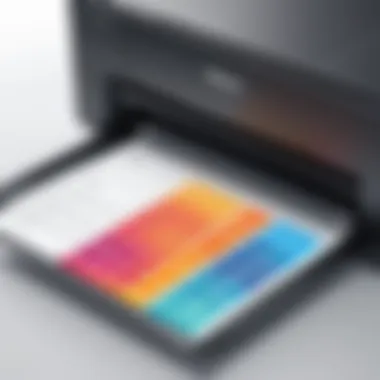Understanding the Cheapest Printer Cost per Page


Intro
Understanding the cost per page of printers is essential for IT professionals and tech enthusiasts. This metric often determines the overall affordability and efficiency of printing operations. As companies and organizations strive to reduce costs, knowing how to assess various printers based on their cost per page becomes crucial. This article delves deep into this subject, exploring performance metrics and usability to guide professionals in making informed decisions.
Performance Metrics
Performance metrics play a significant role in evaluating the true cost associated with a printer. While the initial purchase price may attract buyers, understanding how different factors influence the cost per page can lead to smarter investments.
Benchmarking results
To achieve effective benchmarking results, it is vital to analyze the overall output and print quality in conjunction with operational costs. Recent studies indicate that laser printers, such as the HP LaserJet Pro series, generally present lower costs per page than most inkjet alternatives. Their cartridges tend to print more pages, making them a popular option among businesses with higher volume needs.
Speed and responsiveness
Speed of printers directly affects productivity. A faster printer can maximize the number of pages printed in less time. For instance, the Brother HL-L2350DW boasts impressive printing speeds without compromising quality. The responsiveness of a printer during high-demand times also contributes to user satisfaction, allowing workers to complete tasks more efficiently.
Usability and User Experience
Usability and user experience are critical components when selecting a printer, especially in environments where diverse team members may interact with the device.
Ease of installation and setup
Setting up a printer should not become a daunting task. Models like the Canon PIXMA TS8320 emphasize user-friendly configuration processes. Quick guides and easy-to-follow instructions make these printers less stressful to integrate into office settings.
Interface design and navigation
An intuitive interface simplifies printer interaction. Printers with touchscreens or well-organized menu systems provide a seamless experience. The Epson EcoTank ET-2720 stands out for its navigational ease, offering direct access to essential functions.
Selecting a printer should involve a careful analysis of both performance metrics and usability elements. A comprehensive understanding of these factors leads to cost-effective printing solutions.
Prelims to Cost per Page
In the realm of printing, the term "cost per page" serves as a pivotal metric. Understanding this concept is essential for anyone engaged in regular printing activities. It allows users to assess not just the purchase price of a printer, but also the ongoing expenses that come with its operation. For businesses and tech enthusiasts alike, analyzing cost per page can lead to more informed decisions when selecting a printing solution.
Several factors contribute to the overall cost per page, including printer type, consumables, and maintenance requirements. All these aspects mustbe considered to get a clearer picture of which printer offers the best value over time. This introduction sets the groundwork for delving into these factors in detail, ensuring that readers can evaluate printers based on more than just initial costs.
Defining Cost per Page
Cost per page is a straightforward concept; it refers to the total cost of printing one page. This metric typically includes various costs, such as the price of ink or toner, paper, and maintenance expenses. Calculating this figure accurately helps users determine the most economical printer for their needs.
To calculate cost per page, one two key components: the cost of consumables and the yield of those consumables. For instance, if a black ink cartridge costs $30 and prints 1,000 pages, the cost per page for that ink would be 3 cents.
Importance for Users
The significance of understanding cost per page cannot be overstated. IT professionals and tech enthusiasts rely on detailed insights that go beyond mere upfront costs. Being aware of the total cost implications can directly impact an organization’s budget and operational efficiency.
- Cost per page allows users to make comparisons between different printer models, ensuring they select the most cost-effective options aligned with their printing needs.
- It aids in forecasting long-term expenses as regular printing can quickly escalate costs if not monitored properly.
- Understanding this metric provides stakeholders with leverage when negotiating rates for large print volumes or considering bulk purchases of consumables.
"Cost per page analysis will save more in the long run than any initial savings on printer purchases."
Factors Influencing Cost per Page
Understanding the cost per page is vital for anyone considering a printer. Many factors affect this cost, each playing a unique role. It is essential to analyze these factors to make informed decisions.
Printer Type
Inkjet Printers
Inkjet printers use small nozzles to spray ink directly onto paper. This specific method makes them popular for producing high-quality color prints. The benefit of inkjet printers lies in their versatility. They can handle a wide range of paper types, from plain to glossy. The cost per page for inkjet printers can be higher than other types, especially if a lot of color printing is needed. The unique feature here is that they are often less expensive to buy initially. However, the ongoing ink cartridge expenses can accumulate quickly.
Laser Printers


Laser printers work differently, using toner and a laser to create images. This technology generally leads to faster print speeds and efficiency for black and white documents. Laser printers often have a lower cost per page, especially for high volumes. Their key characteristic is durability and suitability for businesses that require many documents regularly. The drawback is that they can have a higher initial cost compared to inkjet models. It's also worth noting that color laser printing can be expensive, making it less favorable for color-heavy tasks.
Multi-function Printers
Multi-function printers combine printing with scanning, copying, and sometimes faxing. This aspect makes them ideal for both home and office environments, providing versatility in one device. They often come at a reasonable price point and save space. The unique feature is that they can reduce costs by offering multiple functions instead of needing separate machines. However, the long-term cost per page can vary based on the print type being used and the maintenance of the device.
Printing Materials
Paper Quality
The quality of paper plays a significant role in the overall printing cost. Higher quality paper can enhance the final output, especially for professional documents. However, using premium paper increases the cost per page. The key characteristic of paper quality is its impact on print results. Using lower quality paper might save costs initially, but could risk printer damage or subpar print output. Selecting the right paper type can greatly influence long-term printing costs.
Ink or Toner Types
The types of ink or toner used significantly affect printing expenses. Different brands offer various options, impacting the quality and longevity of prints. The key characteristic of ink or toner types is their compatibility with different printers. High-yield cartridges can lower the cost per page in the long run, even if their price seems high at first. Regularly evaluating options based on personal printing habits is beneficial.
Maintenance Costs
Regular Servicing
Regular servicing of printers extends their life and ensures consistent performance. The specific aspect of servicing pertains to its timely intervention for any issues. Routine maintenance helps in keeping the printer functioning at optimal levels. The key characteristic of this servicing is that it can prevent costly repairs later, ultimately saving money in the long run. Users must consider these factors when calculating the total cost of ownership for printers.
Supplies Replacement
Supplies replacement, including ink, toner, and maintenance kits, relates directly to ongoing printer costs. Regularly replacing these items ensures the printer functions efficiently. The key characteristic here is that poorly managed supplies can lead to over-spending or unexpected costs. Users should plan for these expenses in their overall printing budget to avoid surprises. Ensuring compatibility with the specific print device can greatly affect the bottom line.
Comparative Analysis of Printers
A comparative analysis of printers offers vital insights into the varying costs per page across different models and brands. This analysis helps users make informed decisions based on efficiency and long-term expenses rather than just the initial price. Considering the frequency and volume at which printing occurs can lead to substantial savings over time.
By examining leading brands and their characteristics, tech enthusiasts and IT professionals can discern which printer best suits their needs. Various factors, such as cost efficiency and user feedback, further enrich this analysis, providing a comprehensive view of the market.
Understanding these elements is important for optimizing printing strategies and ensuring robust choices that align with budgetary constraints.
Leading Brands
HP
HP is renowned for its extensive range of printers suited for various environments. A key aspect of HP printers is their versatility; they cater to both home and business users. Their printers often come with user-friendly interfaces and many built-in features, making them popular among casual and professional users alike.
One unique feature of HP is the smart app connectivity, which allows remote monitoring and management of print jobs. This can significantly enhance productivity, especially in busy office settings. However, HP printers may have higher upfront costs compared to some competitors, though they can be cost-efficient in the long run due to lower printing costs per page.
Epson
Epson printers are particularly recognized for their ink efficiency. This brand has made notable strides in offering EcoTank technology, which uses refillable ink tanks instead of traditional cartridges. This characteristic results in lower ink costs per page and reduces environmental waste.
The primary benefit of Epson's approach is the potential for significant savings on ink consumption. Still, some users may find the initial purchase price higher, which can lead to hesitation when choosing an Epson printer.
Brother
Brother focuses on reliability and overall cost efficiency. Their printers are frequently praised for their durability, making them a preferred choice for offices that experience high volumes of printing. Another significant advantage is their use of toner cartridges, which typically have a longer lifespan compared to traditional ink cartridges.
Moreover, Brother printers often have low cost per page, which is attractive for businesses with regular printing needs. Contrarily, some Brother models may lack advanced features present in other brands, which could be a disadvantage for tech-savvy users needing extensive functionalities.
Canon
Canon is well-known for producing high-quality images, making their printers a popular choice for graphic design and photography. The key characteristic of Canon printers is their vivid color reproduction, which makes them ideal for those requiring professional-quality prints.
A unique feature of Canon is its ChromaLife 100 systems, which extends the life of prints while maintaining quality. However, users might face higher operating costs, especially for color printing, which can be a consideration for those focused on overall cost per page.
Cost Efficiency


Cost efficiency is a critical metric in determining the viability of a printer investment. Comparing different models based on overall printing costs per page can influence which printer to purchase. Key considerations include the initial purchase price against the longevity and durability of the printer, along with the pricing and availability of consumables.
Analyzing these aspects often reveals a more nuanced view of costs associated with printer ownership beyond the sticker price. Understanding these intricacies allows for better decision-making regarding printing needs.
User Reviews and Feedback
User reviews and feedback serve as valuable resources for understanding real-world experiences related to printers. Tracking common themes in reviews can provide insights into the reliability and day-to-day usability of various models. Users typically highlight aspects such as performance longevity, ease of maintenance, and the responsiveness of customer service.
Collecting external reviews from sites like Reddit or user forums can enhance the understanding of printer efficiency based on direct experiences, ensuring users make well-informed choices in the competitive printer market.
"Cost per page calculations should align with personal or business printing needs, ensuring what seems economical upfront won't lead to unforeseen long-term expenses."
Calculating Your Cost per Page
Calculating your cost per page is essential for determining the true expense associated with printing. This concept impacts not only budgeting for printing needs but also helps in decision-making regarding printer selection. A clear understanding allows users to assess their printing habits and adjust accordingly to minimize costs. This section explores the basic calculation formula and considerations that can influence the cost per page significantly.
Basic Calculation Formula
The basic calculation for cost per page involves a straightforward formula:
In this context, total costs include both the price of consumables such as ink or toner and paper, as well as additional operational expenses tied to the printer. By employing this formula, users find more clarity around their actual printing costs. Precision in the figures is key. An accurate assessment leads to informed choices regarding printer usage and supply purchases.
Considerations for Accurate Estimations
When evaluating the cost per page, certain considerations must be part of the calculation. Two notable elements are print volume and quality settings. Understanding these aspects aids users in achieving an accurate cost estimate.
Print Volume
Print volume refers to the number of pages a user prints within a specific timeframe. The higher the print volume, the lower the cost per page typically becomes due to bulk pricing for supplies. This characteristic of print volume is beneficial because it encourages efficient use of resources. However, the unique feature here is the need for storage of consumables. Sustaining a higher print volume can lead to increased inventory costs, especially if supplies are not tracked effectively, becoming a disadvantage in budgeting efforts.
Quality Settings
Quality settings define the print resolution and the type of output selected by the user. Higher quality prints consume more ink or toner, inflating the overall cost per page. Quality settings can be advantageous when print precision is critical, but they inherently come with increased expenses. Conversely, lower quality settings can produce more economical prints but may sacrifice clarity. Striking a balance can ensure expenses remain manageable while still meeting the necessary output quality for various projects.
An understanding of cost per page calculation is crucial for users aiming to optimize their printing requirements.
In summary, it is clear that calculating the cost per page involves several layers that enhance the insight into printing expenses. Evaluating factors like print volume and quality settings ensures a comprehensive overview and fosters more effective decision-making for those looking to minimize costs.
Cost Reduction Strategies
In the realm of printing, controlling costs becomes essential for both personal and professional environments. Finding ways to reduce the cost per page not only ensures economic efficiency but also impacts operational budgets positively. This section will explore specific strategies aimed at lowering these costs effectively.
Choosing the Right Printer
Selecting the appropriate printer is a critical step in minimizing printing costs. Various printer types offer different advantages and disadvantages regarding cost efficiency.
- Inkjet Printers: Ideal for low-volume printing with high-quality outputs. However, their ink can be costly, which can increase the cost per page significantly if not managed well.
- Laser Printers: Generally, these provide a lower cost per page, especially for high-volume printing. Toner cartridges, while more expensive upfront, often last longer and produce more pages than inkjet cartridges.
- Multi-function Printers: These printers combine multiple capabilities including printing, scanning, and copying. While they might have a higher initial cost, their versatility can lead to cost savings in the long run.
When choosing a printer, consider the average volume of printed pages needed. A printer that handles higher volumes well can reduce the cost per page substantially. User feedback and expert reviews can also inform decisions, helping to identify models renowned for their durability and low-cost printing.
Optimizing Print Settings
The settings selected when printing can greatly influence the total cost per page as well. Several adjustments can help attain a more economical printing approach:
- Draft Mode: Using draft settings can save ink when high-quality results are not needed. This is particularly useful for internal documents that do not require pristine prints.
- Double-Sided Printing: Printing on both sides of the paper significantly reduces the amount of paper used. This not only decreases the overall cost but also contributes positively to environmental sustainability.
- Grayscale Printing: For documents that do not need color, switching to grayscale can cut down ink usage. This is especially wise for text-heavy documents where color is unnecessary.
These adjustments can lead to substantial savings, particularly in environments where printing occurs frequently. Regularly reviewing and adjusting settings based on print needs can keep costs down.
Bulk Purchasing Supplies
Acquiring printing supplies in bulk can also lead to notable cost reductions. Many retailers and manufacturers offer discounts on larger quantities of ink and toner cartridges as well as paper. Here are some points to consider:


- Subscription Services: Some companies provide subscriptions for ink delivery, which can lower overall prices and ensure that supplies are always available when needed.
- Generic Cartridges: Opting for off-brand or remanufactured cartridges can present significant savings. However, it's essential to ensure quality and compatibility with the printer model.
- Paper Quality: While high-quality paper is often more expensive, determining the appropriate balance between quality and cost for specific print jobs will optimize expenses.
Overall, approaching printing as an ongoing cost management process allows individuals and businesses to take strategic actions that limit unnecessary expenses. By integrating these strategies, significant reductions in cost per page can be achieved.
Environmental Considerations
Environmental considerations are strategies that many IT professionals must address when managing their printing operations. These factors play a crucial role in the overall assessment of printer cost per page. Sustainability and eco-friendly practices can correlate with ongoing cost savings and an improved corporate image.
Sustainability in Printing
Sustainable practices in printing encompass several elements. First, manufacturers are increasingly focusing on energy-efficient printers. These devices consume less electricity, thus reducing the carbon footprint associated with printing.
Additionally, the choice of paper is a significant factor. Utilizing recycled paper can reduce waste and lower the demand for new raw materials. Many companies are opting to use paper certified by the Forest Stewardship Council. This certification ensures that the paper is sourced from responsibly managed forests.
Moreover, adopting digital processes can minimize paper usage. By digitizing documents, organizations can substantially reduce the volume of printing required. This shift not only lowers costs in terms of paper and ink but also supports broader sustainability goals.
Recycling Options for Cartridges
Recycling options for cartridges are vital to understanding the broader impact of printing on the environment. Many ink and toner cartridges can be recycled, which helps alleviate the waste created by used cartridges. Companies like HP and Epson offer take-back programs that encourage users to return their spent cartridges for recycling.
Here are several recycling options:
- Drop-off Locations: Many retailers have drop-off points for cartridge recycling.
- Mail-in Programs: Some manufacturers provide prepaid shipping labels so users can send their empty cartridges back for recycling.
- Refilling Services: A practical approach for reducing waste is to refill cartridges instead of discarding them. Some companies specialize in this service, providing a more sustainable alternative to purchasing new cartridges.
"Recycling cartridges not only conserves resources but also supports a circular economy where waste is minimized."
Considering these environmental aspects can influence the choice of printers and printing practices. With the rise of eco-conscious consumers, steering towards sustainable choices may carry long-term financial benefits alongside environmental responsibility.
Future Trends in Printing Technology
Printing technology is evolving rapidly, driven by advancements in digital processes and user demands for efficiency and sustainability. As IT professionals, understanding these trends can help in making informed decisions regarding printer investments while optimizing cost per page metrics.
Advancements in Printer Design
Modern printers are becoming more compact and user-friendly. Manufacturers are integrating smart technology, enabling wireless connectivity and mobile printing capabilities. This shift allows users to print directly from their devices without the need for complex setups or cables. Additionally, enhanced designs often feature energy-efficient components that reduce power consumption, leading to lower operational costs.
As an example, manufacturers like Canon and HP have begun focusing on multifunctional designs, where one device can serve multiple purposes such as printing, scanning, and copying. These all-in-one solutions not only save space but can also lower the cost per page when considering total functionality versus separate devices.
Emerging Cost-efficient Technologies
In response to the growing demand for lower printing costs, several innovative technologies are emerging. One significant trend is the adoption of high-yield cartridges and eco-friendly ink formulations that provide more prints per cartridge. This allows users to achieve lower cost per page while also benefitting the environment.
Furthermore, 3D printing technology is starting to gain traction beyond experimental phases. This offers the possibility of on-demand production, which can significantly reduce waste and material costs.
To summarize key points in this section:
- Usage of Smart Technology: Improved connectivity leads to increased efficiency.
- Multifunctional Devices: Combining services reduces costs and space requirements.
- High-yield Cartridges: More prints mean lower overall expenses.
- 3D Printing: Changing the conventional printing landscape with reduced waste.
"Understanding future trends in printing technology is crucial for IT professionals aiming to optimize costs and enhance operational efficiency."
By staying informed about these advancements, one can make educated decisions that align with both budgetary requirements and environmental considerations.
Epilogue
The conclusion of this article carries significant weight, as it encapsulates the essential insights regarding printer cost per page. Understanding this topic is vital for anyone dealing with printing needs, particularly IT professionals and technology enthusiasts. It highlights the multifaceted nature of printing economics and provides a framework for making informed decisions in a rapidly changing technological landscape.
Summary of Key Points
In summary, several key points emerge from the discussion:
- Cost per Page Definition: The cost per page metric serves as a critical indicator of the financial efficiency of a printer.
- Influencing Factors: Factors such as printer type, materials used, and maintenance can substantially affect this cost.
- Comparative Analysis: By examining leading brands like HP, Epson, Brother, and Canon, users can assess their options based on cost-effectiveness.
- Calculation Methodology: Understanding how to calculate cost per page accurately allows for better budgeting and resource management.
- Cost Reduction: Implementing strategies such as optimizing print settings can lead to significant savings over time.
- Environmental Considerations: Being aware of sustainability can enhance the corporate responsibility of printing decisions.
- Future Trends: Staying informed on advancements in printing technology enables users to adapt to cost-effective solutions.
Final Recommendations
As a final recommendation, users should:
- Evaluate their specific printing needs in relation to volume and type of documents.
- Consider the long-term expenses associated with printer ownership, including maintenance and supply costs.
- Invest time in comparing different models not only for their initial purchase prices but also for their efficiency on a per-page basis.
- Stay updated on technological innovations that promise to improve cost-effectiveness without compromising quality.



